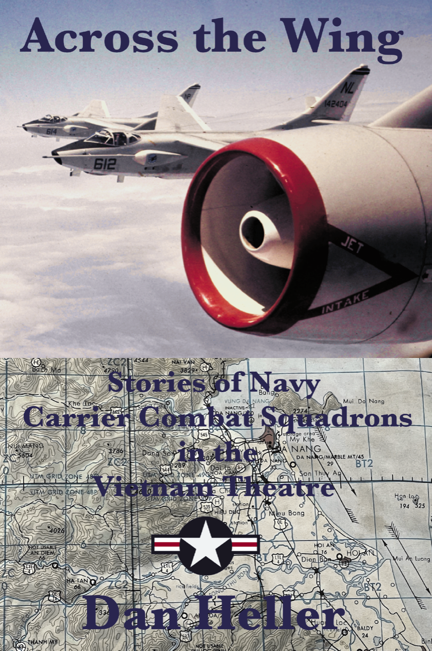
Although severely wounded in World War II, a steel pin in his leg couldn’t hold back John Laughter’s father from receiving a private pilot’s license after the war. John’s mother overcame her fear of flying to become the first licensed female pilot in western North Carolina. His uncle trained pilots during WWII and took John on his first flight in a Stearman biplane. The “Flying Laughters” were proud of young John as he matured into a gifted pilot, talented enough to earn his wings in the U.S. Navy and fly into the most heavily defended country of his era, a place called North Vietnam. This is his story….
“Navy recruiters visited the campus during my third year at college and offered me a ride in a T-34 (Beechcraft Mentor),” the Rockdale County resident recalled. “I said, ‘Yep, this is for me,’ and reported to Pensacola in December of 1964.”
John Laughter soloed in the T-34 at Saufley Field and learned basic acrobatics. His expertise earned him a jet training slot in Meridian, Miss., to master the T-2 (North American Buckeye). Assigned back to Pensacola for gunnery school and carrier qual (qualification), Laughter recalled his first attempt to land on a carrier.
“Honestly, I wasn’t that concerned because of all the Navy training. My first shot (catapult) got the adrenalin pumping, but it was perfect.”
Chase Field in Beeville, Texas: “I flew and trained on the F-9 Cougar and F-11 Grumman Tiger. All went great until the day I rolled in on a target during gunnery practice in an F-11 and the ‘low oil pressure’ light came on. I called in my emergency and headed for Corpus Christi, began my precautionary approach and let the gear down … then the darn plane falls out of the sky. Thrust failed, the gear is sucked back up, my engine power was abnormal …. I’m just hoping for the best. I had to shut down the engine on final and dead stick it back to earth. I made it OK.”
Each and every hour Laughter had spent behind the controls of an airplane now came into play. At Miramar near San Diego, he mastered the F-8 Vought Crusader supersonic Navy fighter before reporting to VF-111 squadron, the legendary Sundowners. In April of 1967 the Sundowners set sail aboard the USS Oriskany, destination: Yankee Station in the Gulf of Tonkin off the coast of North Vietnam.
Laughter said, “We had experienced pilots on the Oriskany who briefed us on their former missions, but it didn’t help much because by that time the Navy had new targets, the capitol city of Hanoi and the critical port of Haiphong. I flew combat escort for A-4 Skyhawks, flak suppression missions, Tarcap, Barcap, Migcap, plus photo recon escort. We lost one plane per day the first week, didn’t lose one the next day, then lost two the following day.”
As the air war escalated, so did the losses. “It was tough when we lost someone,” Laughter said. “You’d sit in a briefing room with 30 guys and knew at least one wouldn’t be coming back. The A-4 Skyhawks really took a pounding during our first cruise …. about 28 planes either lost or damaged. We faced 37mm, 57mm, 85mm, and 100mm anti-aircraft guns plus SAMs (surface to air missiles). Some of the planes returned with holes large enough to stick your head through.”
July 29, 1967 aboard their sister ship, the USS Forrestal: “The Forrestal was launching planes when a Zuni missile misfired. The runaway Zuni struck a fully fueled and armed A-4 Skyhawk piloted by future senator and presidential candidate John McCain. He survived, but our sister carrier had lost 134 men killed, 161 injured, and 21 aircraft destroyed. The pilots and planes that survived were sent over to us, the Oriskany, so we could continue our missions.”
Late October, 1967: “We struck the thermal power plant in Hanoi. It was on that mission that John McCain went down and became a POW for five and a half years, including two years in solitary confinement. We were using the first ‘smart bomb’ by then, the Walleye, but the North Vietnamese already knew how to jam or evade the weapon. They had inside info; we had a traitor somewhere back in the States.”
Their tour complete, the Oriskany headed for Hong Kong for rest and recreation. “That didn’t last long,” Laughter said. “The replacement carrier was delayed so we went back in action for 10 more days. Those 10 days cost us two more planes and two more pilots. But we never backed down, we continued to hit them hard; we did the best we could under the circumstances, for our country, our squadron, and our wingman.”
Laughter served a second cruise in the Gulf of Tonkin. “That wasn’t exactly a cake walk but did offer less of a risk,” he said. “President Johnson had taken Hanoi, Haiphong, and other important targets off the bombing list. We still lost planes, but not as many as on the first cruise. We did our job, and we were proud of our service.”



Be the first to comment